Motion ICSE Class-7th Concise Selina Physics Solutions Chapter-2. We Provide Step by Step Answer of Objective, True False , Fill in the blanks, Match the following , Short / Long Answer Type , Numericals of Exercise-2 Motion. Visit official Website CISCE for detail information about ICSE Board Class-7.
Motion ICSE Class-7th Concise Selina Physics Solutions Chapter-2
A. Objective Questions Chapter-2 Motion ICSE Concise Selina
1. Write true or false for each statement
(a) Two trains going in opposite directions with the same speed are at rest relative to each other.
Answer. False.
(b) A ball is thrown vertically upwards. Its motion is uniform throughout.
Answer. False.
(c) The motion of a train starting from one station and reaching at another station is non-uniform.
Answer. True.
(d) A motion which repeats itself after a fixed interval of time is called periodic motion.
Answer. True.
(e) A ball thrown by a boy from a roof-top has oscillatory motion.
Answer. False.
(f) Mass has both magnitude and direction.
Answer. False.
(g) .Weight always acts vertically downwards.
Answer. True
(h) Mass varies from place to place but weight does not.
Answer. False
2. Fill in the blanks Motion ICSE Class-7th Concise
(a) Two boys cycling on the road with the same speed are at rest relative to each other.
(b) The motion in a straight line is rectilinear motion.
(c) One to and fro motion of a clock pendulum takes time = 2 s
(d) 36 km h-1 = 10 m s-1
(e) Total distance travelled = average speed × total time taken.
(f) The weight of a girl is 36 kgf. Her mass will be 36 kg.
(g) The weight of a body is measured using a spring balance.
Activity
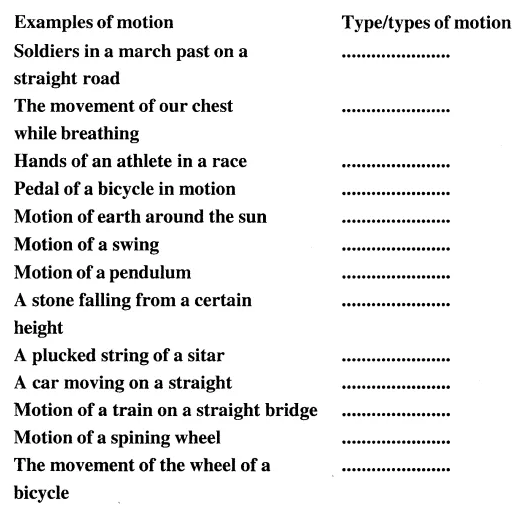


3. Match the following Chapter-2 Motion ICSE Class-7th Concise
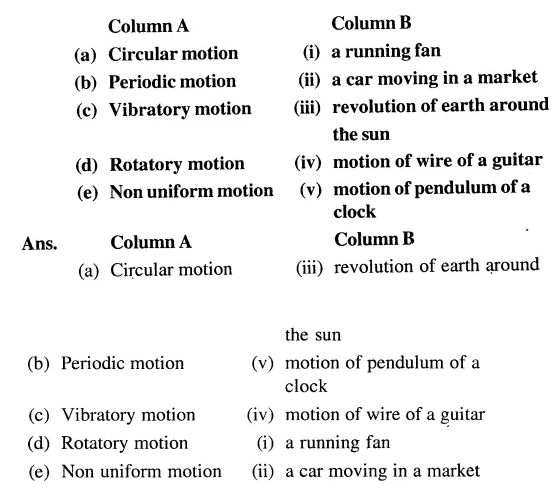
4. Select the correct alternative
(a) A book lying on a table is an example of
- a body at rest
- a body in motion
- a body neither at rest nor in motion
- none of these
Answer
a body at rest
(b) The motion of a pendulum is
- rotatory
- oscillatory
- curvilinear
- rectilinear
Answer
oscillatory
(c) A car moving on a straight road is an example of
- rotatory motion
- rectilinear motion
- oscillatory motion
- periodic motion
Answer
rectilinear motion
(d) A ball falls down vertically. Its motion is
- periodic
- linear
- circular
- vibratory
Answer
linear
(e) If a body covers equal distance in equal interval of time, the motion is said to be
- uniform
- non-uniform
- oscillatory
- rotatory
Answer
uniform
(f) A boy goes from his house to school by bus at a speed of 20 km h_1 and returns back through the same route at a speed of 30 km h_1. The average speed of his journey is
- 24kmh1
- 25 km h1
- 30 km h1
- 20 km h1
Answer
24kmh1
(g) The earth attracts a body of mass 1 kg with a force of 10 N. The mass of a boy is 50 kg. His weight will be
- 50 kg
- 500 N
- 50 N
- 5 N
Answer
500 N
B. Short/Long Answer Questions Motion ICSE Class-7th Concise
Question 1.
Explain the meaning of the terms rest and motion.
Answer:
Rest— A body is said to be at rest if it does not change its position with respect to its immediate surroundings.
Motion— A body is said to be in motion if it changes its position with respect to its immediate surroundings.
Question 2.
Comment on the statement ‘rest and motion are relative terms’. Give an example.
Answer:
Imagine you are sitting inside a moving bus. When you look outside you will observe that you are moving. Now look to the roof of the bus. With respect to the roof of bus, you are at rest. Hence it is concluded that rest and motion are relative terms.
Question 3.
Fill in the blanks using one of the words : at rest, in motion.
(a) A person walking in a compartment of a stationary train is relative to the compartment and is relative to the platform.
(b) A person sitting in a compartment of a moving train is relative to the other person sitting by his side and is relative to the platform.
Answer:
(a) A person walking in a compartment of a stationary train is in motion relative to the compartment and is in motion relative to the platform.
(b) A person sitting in a compartment of a moving train is at rest . relative to the other person sitting by his side and is in motion relative to the platform.
Question 4.
Name five different types of motion you know.
Answer:
The different types of motion are :
1. Translatory motion
2. Rotatory motion
3. Oscillatory motion
4. Vibratory motion
5. Periodic motion
6. Multiple motion
7. Random motion.
Question 5.
What do you mean by translatory motion ? Give one example.
Answer:
If an object like a vehicle, moves in a line in such a way that every point of the object moves through the same distance in the same time, then the motion of the object is called translatory motion.
Example :
The motion of an apple falling from a tree, the motion of a man walking on a road, the motion of a box when pushed from one comer of a room to the other, are all the translatory motion.
Question 6.
Explain the meanings of (i) rectilinear motion, and (ii) curvilinear motion. Give one example of each.
Answer:
(i) Rectilinear motion — If the motion of a body is along a straight line, it is said to be the rectilinear or linear motion. The motion of bullet fired from a gun.
(ii) Curvilinear motion — If the motion of a body is along a curved path, it is said to be the curvilinear motion. For example, the motion of a cycle while taking a turn on the road, a car moving along a curved path, a ball thrown by an athlete are in curvilinear motion.
Question 7.
What is rotatory motion ? Give two examples.
Answer:
Rotatory motion— A body is said to be in a rotatory motion or a circular motion if it moves about a fixed axis without changing the radius of its motion.
Examples : The blades of a fan, a spinning wheel.
Question 8.
What is meant by circular motion ? Give one example.
Answer:
The motion of a body along a circular path is called circular motion.
Example : A girl is whirling a stone tied at the end of a string in a circular path
Question 9.
How does a rotatory motion differ from the circular motion?
Answer:
(i) In rotatory motion, the axis of rotation passes from a point
in the body itself whereas in circular motion, the axis of revolution passes through a point outside the body. Thus the motion of earth around the sun is the circular motion whereas the motion of earth about its own axis is the rotational motion.
(ii) In the circular and rotatory motions, the distance of a point of a the body from a fixed point always remains same, whereas it is not same in curvilinear motion.
Question 10.
Explain oscillatory motion by giving one example.
Answer:
Oscillatory motion— The to and fro motion of a simple pendulum is an oscillatory motion.
Example : 1. The motion of a swing, 2. Piston of an engine.
Question 11.
What is vibratory motion ? Give one example.
Answer:
In vibratory motion, a part of the body always remains fixed and the rest part moves to and fro about its mean position. During the vibratory motion, the shape and size of the body changes. Example : When we breath, our chest expands and contracts. This motion is vibratory motion.
Question 12.
Differentiate between periodic and non-periodic motions by giving an example of each.
Answer:
Periodic motion : A motion which gets repeated after regular intervals of time is called a periodic motion.
Examples : The earth moving around the sun takes 365 days to complete one revolution and this motion gets repeated after every 365 days.
Non-periodic motion : The motion which does not repeat itself after regular interval of time is called non-periodic motion.
Examples : A footballer running on a field, application of brakes in a moving vehicle, a ball rolling down the ground gradually slows down and finally stops, motion of tides in the sea, etc.
Question 13.
What is random motion. Give one example.
Answer:
Random motion— When an object in a motion has no specific path and which suddenly changes its motion is said to have a random motion.
Example : A flying kite.
Question 14.
Name the type/types of motion being performed by each of the following:
(a) Vehicle on a straight road
(b) Blades of an electric fan in motion
(c) Pendulum of a wall clock
(d) Smoke particles from chimney
(e) Hands of a clock
(f) Earth around the sun
(g) A spinning top.
Answer:
(a) Rectilinear motion
(b) Rotatory motion
(c) Oscillatory motion, periodic motion
(d) Non-periodic motion
(e) Uniform circular and periodic motion
(f) Rotatory motion, circular motion and periodic motion
(g) Rotatory motio
Question 15.
Give two examples to illustrate that a body can have two or more types of motion simultaneously.
Answer:
Sometime a body can have more than one type of motion. Such a motion is called the mixed motion.
Example :
(i) The wheels of a moving train have both the translatory as well as the rotatory motions as it moves from position A to position B while rotating.
(ii) The earth rotates about its axis (rotatory motion) and at the same time it revolves around the sun in a curved path (curvilinear or circular motion) in a fixed time interval (periodic motion).
Question 16.
State the types of motion of the following :
(a) The needle of a sewing machine
(b) The wheel of a bicycle
(c) The drill machine
(d) The carpenter’s saw
Answer:
(a) Periodic motion
(b) Rotatory motion
(c) Mixed = Translatory and Rotatory motion
(d) Mixed = Translatory and Oscillatory motion
Question 17.
Distinguish between uniform and non-uniform motions, giving an example of each.
Answer:
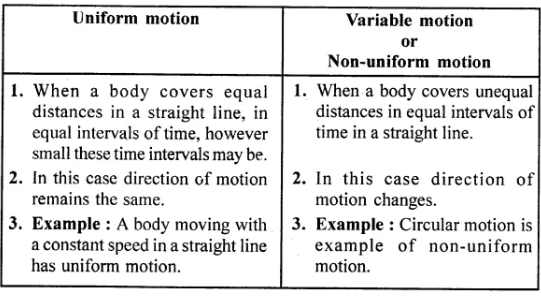
Question 18.
How do you determine the average speed of a body in non-uniform motion ?
Answer:
In a non-uniform motion, the average speed of a body is calculated by dividing the total distance travelled by the body, with the total time of its journey. Thus,
Average speed = Total distance travelled by the body / Total time ofjoumey
Question 19.
Define the term weight and state its S.I. unit.
Answer:
The weight of a body is the force with which earth attracts the body i.e. the weight of a body is the force of gravity on it. The weight of a body is not constant, but it changes from place to place. It is represented by the symbol W. The S.I. unit of weight is newton (N).
Question 20.
How are the units of weight, kgf and newton related ?
Answer:
1 kg F = 10 N
Question 21.
State three differences between mass and weight.
Answer:
Mass
It is the quantity of mattercontained in a body.
Its S.J. unit is kilogram (kg)
It is constant for a body and it does not change by changing the place of the body.
It is measured by a beam balance.
Weight
It is the force with which the earth attracts the body.
Its S.I. unit is newton (N) and other unit is kilogram-force (kgf) where 1 kgf= 1ON(nearly).
It is not constant for a body, but it changes from place to place.
It is measured by a spring balance.
Question 22.
Which quantity : mass or weight, does not change by change of place ?
Answer:
The mass of a body is constant and it does not change by changing the position of the body.
Question 23.
State which of the quantities, mass or weight is always directed vertically downwards.
Answer:
Mass is the quantity of matter contained in a body. Weight is the force with which the earth attracts the body. Weight is always directed vertically downwards.
C. Numericals Motion ICSE Class-7th Concise
Question 1.
A car covers a distance of 160 km between two cities in 4 h. What is the average speed of the car ?
Answer:
Distance =160 km
Time taken = 4h
Speed = ?
Speed = Distance covered / Time taken
= 160km / 4h = 40 km h-1
Question 2.
A train travels a distance of 300 km with an average speed of 60 km h_1. How much time does it take to cover the distance?
Answer:
Speed = 60 km h-1
Distance covered = 300 km
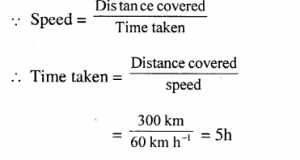
Question 3.
A boy travels with an average speed of 10 m s-1 for 20 min. How much distance does he travel ?
Answer:
Average speed of boy = 10 m s-1
Time taken = 20 min
Distance travelled = Speed × Time taken
Convert minutes into seconds
1 minute = 60 sec.
20 minutes = 20 × 60 = 1200 sec.
Distance travelled = 10 m s-1 × 1200 sec.
= 12000 m Or 12 km
Question 4.
A boy walks a distance 30 m in 1 minute and another 30 m in 1.5 minute. Describe the type of motion of the boy and find his average speed in m s-1.
Answer:
As the speed does not remain constant throughout the journey the motion is non-uniform
Total distance travelled in going and coming back
d = 30 m + 30 m = 60 m
Total time taken in going and coming back

Question 5.
A cyclist travels a distance of 1 km in the first hour, 0.5 km in the second hour and 0.3 km in the third hour. Find the average speed of the cyclist in
(i) km h-1, (ii) m s-1.
Answer:
(a) Distance travelled in first hour = 1 km
Distance travelled in second hour = 0.5 km
Distance travelled in third hour = 0.3 km
Total time taken = 3 hr
Total distance travelled = 1 + 0.5 + 0.3 = 1.8 km
(i) Average speed in km h-1

Question 6.
A car travels with speed 30 km h-1 for 30 minute and then with speed 40 km h-1 for one hour. Find :
(a) the total distance travelled by the car
(b) the total time of travel, and
(c) the average speed of car
Answer:
Speed of car for first 30 minutes = 30 km h-1
Speed of car for next 1 hour = 40 km h-1
(a) Total distance travelled by the car

Question 7.
On earth the weight of a body of mass 1.0 kg is 10 N. What will be the weight of a boy of mass 37 kg in (a) kgf (b) N ?
Answer:
Weight of a body of mass 1.0 kg body = 10 N
(a) Weight of a boy of mass = 37 kg
(b) Weight of a boy of 37 kg in newton will be 1 kgf = 10N
∴ 37 kgf = 37 × 10 N
= 370 N
Question 8.
The weight of a body of mass 6.0 kg on moon is 10 N. If a boy of mass 30 kg goes from earth to the moon surface, what will be his (a) mass, (b) weight ?
Answer:
(a) Mass remains same it does not change
So mass of boy 30 kg on earth = 30 kg on moon surface
(b) Weight of boy on moon becomes 1 / 6
∴ 30 kg boy will weight 30 x 1/6 = 5kg
1 kg = 10 N ⇒ 5 × 10 N = 50 N
∴ Weight of boy on moon surface = 50 N
Return to – ICSE Class-7 Selina Physics Solution
Thanks
Please share with your friends
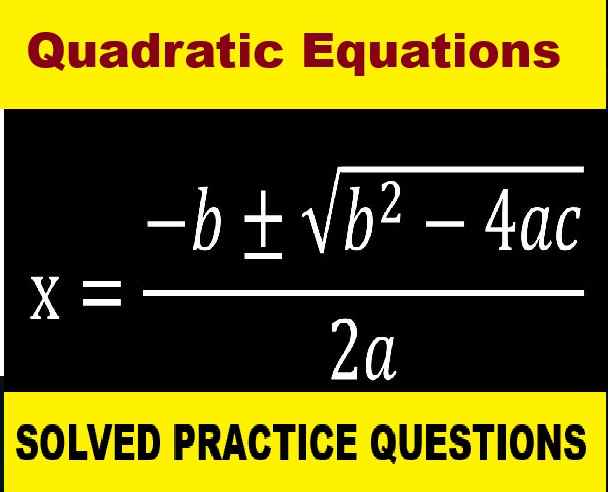

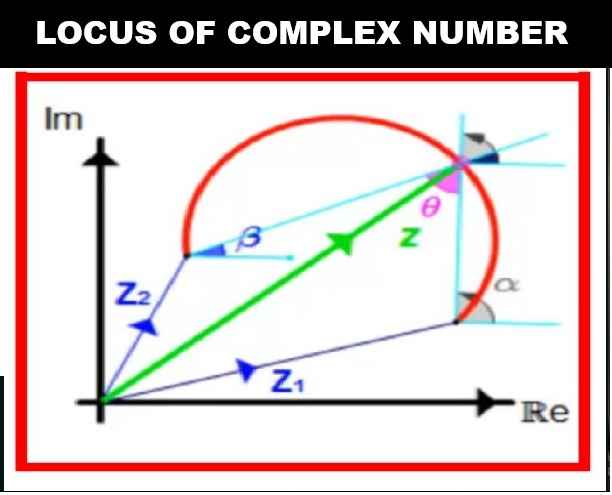
Very helpful and nice app
thanks for positive response
icsehelp.com is a highly regarded educational platform tailored to the needs of students following the ICSE (Indian Certificate of Secondary Education) curriculum. Here are some key points that highlight its effectiveness:
Comprehensive Study Material:
The platform offers a wide range of study materials, including detailed notes, previous years’ question papers, sample papers, and solutions. This variety ensures that students can find resources to suit their specific needs.
Quality Content:
The content on icsehelp.com is curated by experienced educators and subject matter experts. This ensures that the material is accurate, up-to-date, and aligns with the latest ICSE syllabus.
User-Friendly Interface:
The website is easy to navigate, with a clean layout and intuitive design. This makes it accessible for students of all ages and technical abilities, ensuring they can find what they need without any hassle.
Practice and Revision:
With an extensive collection of practice papers and mock tests, students can regularly test their knowledge and prepare effectively for their exams. The immediate feedback and solutions provided help in identifying areas that need improvement.
Interactive Learning:
icsehelp.com offers interactive quizzes and exercises, making learning more engaging and fun. This interactive approach helps in better retention of information and makes studying less monotonous.
Regular Updates:
The platform is regularly updated with new content, ensuring that students always have access to the latest information and study materials. This is particularly important in subjects where the syllabus may change frequently.
Support and Guidance:
The website provides guidance on exam preparation strategies, time management, and stress management, helping students to approach their exams with confidence and a clear plan.
Affordability:
icsehelp.com offers many of its resources for free or at a very reasonable cost, making it accessible to a wide range of students from different backgrounds.
Overall, icsehelp.com is an excellent resource for ICSE students. Its comprehensive and high-quality study materials, user-friendly interface, interactive learning tools, and affordability make it a valuable asset for anyone looking to excel in their ICSE exams.
thanks for positive response all feature described by you are correct but a single argument that icsehelp offer this at reasonable rate against our policy. All the content at icsehelp is absolutely free and never demanded for any money / subscription charge
again thanks a lot